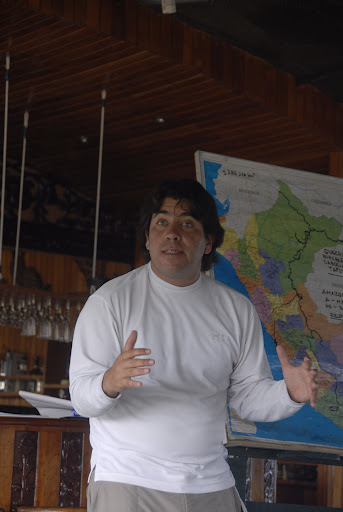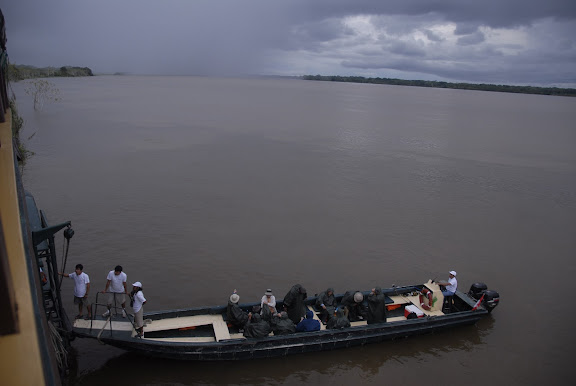Follow photographer, Elizabeth Cryan, through her photographic journey around the world.
Sunday, April 17, 2011
The Amazon
Have you ever encountered a true "birder"? It wasn't until this past week that I had the opportunity to meet not only one, but 16 avid birders on board La Amatista for a week long riverboat trip down 700 miles of the Amazon's 4,000 miles. And let me tell you, they are amazing! I would equate their love of bird watching to my love of the underwater world, although when you are underwater, you are limited to just pointing and hand gestures without the ability to verbally communicate. The enthusiasm is both astounding and a bit contagious. I was also very amused since I have never been that into birds before. So, we would be going down one of the side creeks, having gone about five inches, when you would hear "OHHHHHH.... Oooohhh.... Looooook... Theres the rare blue bellied kukawhaqalakamungachanga.... Oooooooh!!!!!" and you would get all excited at this incredible sighting and respond, "Where?!" and they would say "Ok, go to the farthest and tallest tree (which would be about a mile away) and look at the second branch just above those greenish leaves, and its there!". So, you'd look at the spot through the binoculars and all you would see is a silouetted spec that might move every once in a while. It was hysterical to me. The birds that were actually close to the boat (that I could see!) were stunning. They were so vibrant and its amazing to see all of their different colors. Of note is the fact that the Amazon Basin is home to an astounding percentage of the world's bird species.
Great Egret
La Amatista
Great Potoo (very difficult to see during the day.)
Along with the many birds, we also saw a number of different species of monkeys, the caiman (which is similar to the alligator), the capybara, the largest rodent in the world which looks like an enlarged guinea pig weighing around 120 pounds, snakes, pink river dolphin, grey dolphin, many species of frogs including the red poison dart frog, the Pygmy Hatchetface Leaf frog, tarantulas, and much more.
Pygmy Hatchetface Leaf frog
olive Whip Snake
Naturalist, George, showing everyone the Olive Whip Snake
Caiman
Capybara
Red Poison Dart Frog
Pink River Dolphin
One of the main highlights for me was visiting two villages of the "River People" and learning about their way of life, medicines, schooling, etc. Not knowing that we were coming, the excitement and interest of the kids was genuine as they raced down to meet our skiffs. These people were incredibly kind, and welcomed us into their villages, showed us one of their houses and gardens, illustrated how to get sugar cane juice out of the sugar cane, and a medicine man showed us the different local herbal remedies for a number of illnesses. Each year, the Amazon river rises at least 40 feet during the rainy season, although the majority of the water comes from the snow melt off of the Andean Mountains. So, unless their houses are built on high enough stilts, some of the river people have to move to a different area as their houses get completely flooded, before returning when the water recedes (as they are used to doing). Both villages that we visited were on terra firma, or dry land.
Photo by guide, Dennis
Photo by Mom
The guides that we had on the trip couldn't have been better. They were incredibly informed, intelligent, and enthusiastic. Each day, one of them would give a talk about the Amazon, the people, and the history and current political situation of Peru. It was fascinating and made each experience, whether bird and animal watching, fishing for piranhas, eating the delicious Peruvian cuisine, or visiting the local villages that much more substantial and fulfilling. Some of the interesting things that we learned were that the Amazon river is the largest and longest river system in the world and contains 2/3rds of all the unfrozen fresh water on Earth. The Amazon empties out into the Atlantic Ocean, and the amount of fresh water that empties out into the Atlantic in one day (up to 500 billion cubic feet of water) could sustain New York City's fresh water needs for 9 years. Woah.
Expedition Leader, Jorge
Looking at the bats
Fishing for pirahanas
Mom's big catch - catfish
Mom and I are currently in Cusco for Semana Santa, or holy week.
In Lima
Subscribe to:
Post Comments (Atom)



































I do feel sorry for those two rabbits, but dang Liz, love the photos and how much I learn from reading your blog. Go on another adventure, soon! Okay?
ReplyDeleteHope you guys are having a great time, love the pictures
ReplyDeleteCat fish are bigger than at the camp.
ReplyDeleteLove,
Ruthie
Ithe foot on the little boy in the orange pants make the shot so endearing!
ReplyDeleteR